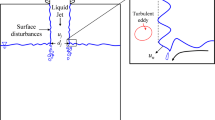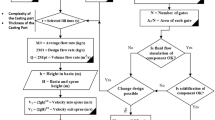Abstract
Air entrainment during mold filling is a major source of oxide inclusion formation in metal casting. A model was recently developed by the authors to predict the volumetric air entrainment during pouring of metal castings. In the course of validating the model with experimental data for plunging liquid jets, it was shown that the air entrainment rate during mold filling depends fundamentally on the velocity and diameter of the jet formed by the pouring stream. In this study, the effect of more complex pouring conditions and gating system design on air entrainment is examined. Simulations are performed investigating the air entrainment characteristics of castings filled without a gating system, and with bottom-gated and side-gated filling systems. Results indicate that reducing the head height and pouring time, and the addition of a nozzle extension significantly reduces the air entrainment. In addition, using an offset pouring basin with a stopper and pressurizing the gating system further reduces the volume of entrained air. Simulation results also show that the generation of vortex flows inside the filling system is beneficial in reducing free surface turbulence, which results in less air entrainment and oxide inclusion formation during mold filling.














Similar content being viewed by others
References
J. Campbell, Complete Casting Handbook: Metal Casting Processes, Metallurgy, Techniques and Design, 2nd edn. (Butterworth-Heinemann, Oxford, 2015)
A.J. Melendez, K.D. Carlson, C. Beckermann, Modelling of reoxidation inclusion formation in steel casting. Int. J. Cast Met. Res. 23, 278–288 (2010)
D.R. Askeland, P.K. Trojan, R.A. Flinn, Dross Formation reactions in the system Mg–Si–O in ductile iron. AFS Trans. 80, 349–358 (1972)
A.K. Biń, Gas entrainment by plunging liquid jets. Chem. Eng. Sci. 48, 3585–3630 (1993)
D.A. Ervine, E. McKeough, E.M. Elsawy, Effect of turbulence intensity on the rate of air entrainment by plunging water jets. ICE Proc. 69, 425–445 (1980)
K.J. Sene, Air entrainment by plunging jets. Chem. Eng. Sci. 43, 2615–2623 (1988)
T. Brattberg, H. Chanson, Air entrapment and air bubble dispersion at two-dimensional plunging water jets. Chem. Eng. Sci. 24, 4113–4127 (1998)
J. Campbell, Entrainment defects. Mater. Sci. Technol. 22, 127–145 (2006)
A. Kheirabi, A. Baghani, A. Bahmani, M. Tamizifar, P. Davami, M. Ostad Shabani, A. Mazaher, Understanding the occurrence of the surface turbulence in a nonpressurized bottom gating system: numerical simulation of the melt flow pattern. Proc. IMechE Part L J. Mater. Des. Appl. 232, 230–241 (2018)
N.W. Lai, W.D. Griffiths, and J. Campbell, Modelling of the potential for oxide film entrainment in light metal alloy castings. in MCWASP X, D.M.Stefanescu, J.A. Warren, M.R. Jolly, and M.J.M. Krane, eds., TMS, Warrendale, PA, 415–422 (2003)
F.-Y. Hsu, M.R. Joly, J. Campbell, Vortex-gate design for gravity casting. Int. J. Cast Met. Res. 19, 38–44 (2006)
X. Yang, X. Huang, X. Dai, J. Campbell, J. Tatler, Numerical modelling of entrainment of oxide film defects in filling of aluminium alloy castings. Int. J. Cast Met. Res. 17, 321–331 (2004)
M.C. Latona, H.W. Kwon, J.F. Wallace, J.D. Voss, Factors influencing dross formation in ductile iron castings. AFS Trans. 92, 881–906 (1984)
C. Reilly, N.R. Green, M.R. Jolly, J.C. Gebelin, The modelling of oxide film entrainment in casting systems using computational modelling. Appl. Math. Model. 37, 8451–8466 (2013)
Y. Yue, Modelling of the effects of entrainment defects on mechanical properties in Al–Si–Mg alloy castings, Ph.D. diss. (University of Birmingham, Birmingham, 2014)
C. Wanstall, J. Griffin, C.E. Bates, Water modeling of steel pouring practices. In: Proceedings of the 47th SFSA Technical and Operating Conference, Chicago, IL, Paper No. 1.1 (1993)
C.E. Bates and J. Griffin, Clean cast steel technology. Research report no. 106, Steel Founders’ Society of America (SFSA), Crystal Lake, IL, USA (1994)
S. Kuyucak, Sponsored Research: clean steel casting production—water modeling studies of bottom-pouring ladle operations. AFS Trans. 114, 811–818 (2006)
P.K. Trojan, P.J. Guichelaar, R.A. Flinn, An investigation of entrapment of dross and inclusions using transparent whirl gate models. AFS Trans. 74, 462–469 (1966)
J. Ma, A.A. Oberai, D.A. Drew, R.T. Lahey, M. Hyman, A comprehensive sub-grid air entrainment model for RANS modeling of free-surface bubbly flows. J. Comput. Multiph. Flow 3, 41–56 (2011)
S.H. Majidi, C. Beckermann, Modelling of air entrainment during pouring of metal castings. Int. J. Cast Met. Res. 30, 301–315 (2017)
S.H. Majidi, J. Griffin, C. Beckermann, Simulation of air entrainment during mold filling: comparison with water modeling experiments. Metall. Mater. Trans. B 49B, 2599–2610 (2018)
MAGMAsoft, MAGMA Gmbh, Kackerstrasse 11, 52072 Aachen, Germany
Author information
Authors and Affiliations
Corresponding author
Rights and permissions
About this article
Cite this article
Majidi, S.H., Beckermann, C. Effect of Pouring Conditions and Gating System Design on Air Entrainment During Mold Filling. Inter Metalcast 13, 255–272 (2019). https://doi.org/10.1007/s40962-018-0272-x
Published:
Issue Date:
DOI: https://doi.org/10.1007/s40962-018-0272-x




